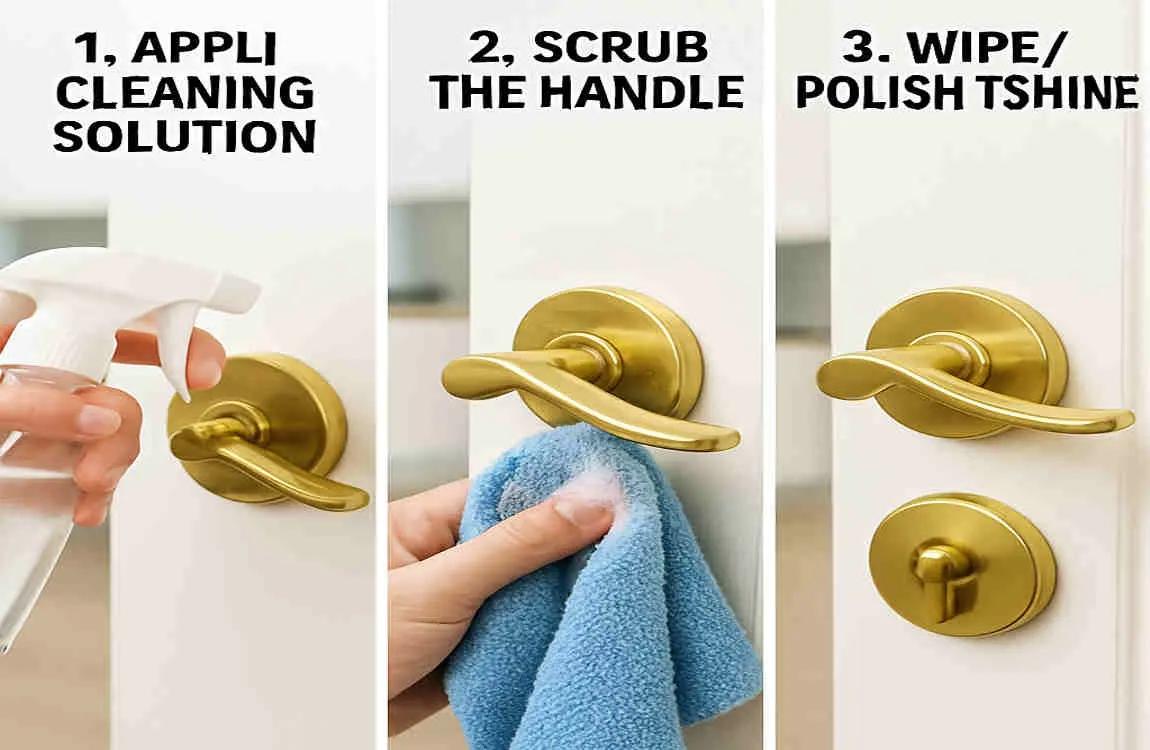Maintaining a clean home involves more than just dusting surfaces and vacuuming floors. One often-overlooked area is door handles. These high-touch surfaces can harbour dirt, grime, and germs, making it essential to maintain their cleanliness. Not only do clean door handles enhance the aesthetics of your home, but they also play a crucial role in maintaining hygiene, especially in households with children or frequent visitors.
Why Cleaning Door Handles is Important

Door Handles as Germ Hotspots
Door handles are among the most frequently touched items in any home. Each time someone enters or exits a room, they feel the handle, transferring oils, dirt, and bacteria to it. Studies have shown that door handles can be a breeding ground for germs and viruses, making it imperative to clean them regularly.
Preventing the Spread of Bacteria and Viruses
Regular cleaning of door handles is vital in preventing the spread of illnesses, particularly during cold and flu seasons. By maintaining a clean environment, you can significantly reduce the likelihood of transmitting germs among family members and guests.
Effects of Dirt and Grime
Besides health concerns, accumulated dirt and grime can tarnish the appearance of your door handles. Over time, this buildup can lead to dullness and even damage the finish, affecting the longevity of the handles. Whether in a family home, an office, or a public space, cleanliness should be a top priority.
Importance for Different Households
For families with children or pets, the need for regular cleaning becomes even more critical. Kids are known to touch everything, and pets may also contribute to the buildup. In offices, where many people interact with the same handles, cleanliness is essential to maintain a professional appearance and ensure the health of employees.
Types of Door Handles and Their Cleaning Requirements
Overview of Common Door Handle Materials
You may also read (how to identify chlorine smells in your home).
Different materials require different cleaning approaches. Here’s a breakdown of the most common types of door handles:
- Brass (lacquered & uncoated)
- Chrome and polished metal
- Stainless steel
- Oil-rubbed bronze
- Wood and coated handles
- Plastic or synthetic materials
Specific Cleaning Considerations
Each type of material has unique cleaning requirements. Here are some considerations:
- Brass: Avoid harsh chemicals, as they can damage the finish. Use gentle cleaners.
- Chrome and Polished Metal: These surfaces require mild soap and water for cleaning. Avoid abrasive scrubbers to maintain their shine.
- Stainless Steel: Use recommended cleaning agents specifically designed for stainless steel to prevent streaks.
- Oil-Rubbed Bronze: A mild soap solution works best. Always dry immediately to protect the finish.
- Wood Handles: Use a soft, damp cloth to prevent damage to the wood.
- Plastic Handles: Generally easy to clean with soapy water, but be cautious with strong chemicals that may cause discolouration.
Testing Cleaning Solutions
Before applying any cleaning solution, it’s wise to test it on a hidden area of the handle. This helps ensure that the cleaner won’t damage the finish.
With this knowledge, you can effectively address the specific needs of your door handles, making cleaning a more targeted process.
Supplies and Tools Needed to Clean Door Handles
Essential Supplies for Universal Cleaning
To clean door handles effectively, gather the following supplies:
- Soft cloths: These help prevent scratches during cleaning.
- Microfiber cloth: Ideal for polishing and removing fingerprints.
- Mild dish soap: Gentle on surfaces but effective against grime.
- Warm water: Use it to mix with soap for general cleaning.
- White vinegar: Great for cleaning brass handles.
- Baking soda: Effective for tackling tough stains.
- Soft-bristle brush or old toothbrush: Useful for reaching crevices.
- Disinfectant sprays or wipes: Ensure they are safe for your specific handle materials.
Optional Specialised Cleaners
To enhance your cleaning routine, consider investing in specialised cleaners designed for specific materials. For example, a metal polish can help restore shine to chrome and stainless steel handles.
Eco-friendly and Cost-effective Options
Using household items like vinegar and baking soda not only saves you money but also reduces your exposure to harsh chemicals. Cultivating awareness about eco-friendly options contributes to a healthier home environment.
Step-by-Step Guide: How to Clean House Door Handles Effectively

Cleaning door handles doesn’t have to be a daunting task. Here’s a straightforward step-by-step guide to follow:
Preparation
You may also read (how to prevent moles from getting under your house).
- Remove Dust and Loose Dirt: Start by using a dry cloth to wipe away dust and loose dirt. This simple step makes the subsequent cleaning more effective.
Warm Soapy Water Cleaning
This method is ideal for most handles:
- Mix Warm Water and Dish Soap: Combine warm water with a few drops of mild dish soap.
- Dip Cloth: Soak a soft cloth in the solution.
- Wipe Handles Thoroughly: Gently clean the handles, ensuring you get into any crevices.
- Rinse and Dry: Use a clean, damp cloth to gently rinse off soap residue, then dry with a soft, dry cloth.
Cleaning Brass Handles
For brass handles, follow these steps:
- Make a Paste: Mix baking soda, vinegar, and flour to form a paste.
- Apply Gently: Rub the paste onto the brass handle using a soft cloth.
- Let Sit: Allow it to sit for a few minutes to break down tarnish.
- Rinse and Buff: Rinse with clean water and buff with a dry cloth for shine.
Polished Chrome and Metal Handles Cleaning
To keep chrome and metal handles gleaming:
- Use Mild Soap and Water: Mix with warm water.
- Avoid Abrasive Scrubbers: Use a soft cloth to wipe down.
- Polish with Microfiber Cloth: After cleaning, polish to restore shine.
Oil-Rubbed Bronze Handles Cleaning
For oil-rubbed bronze handles:
- Mild Soap Solution: Use a gentle soap solution.
- Avoid Scrubbing: Wipe gently to avoid damaging the finish.
- Dry immediately: This protects the finish from water spots.
Disinfection Step
After cleaning, it’s crucial to disinfect:
- Use Safe Disinfectant: Apply a disinfectant spray or wipe that is safe for your handles.
- Follow Instructions: For optimal results, follow the manufacturer’s instructions carefully.
Drying and Polishing
After cleaning and disinfecting, dry and polish the handles with a soft cloth for a final touch.
Safety Tips
- Always avoid harsh chemicals that can damage finishes.
- Never use abrasive scrubbers on delicate surfaces.
Handling Stubborn Stains and Tarnishes
Common Causes of Stubborn Stains
Stubborn stains can result from various factors, including:
- Frequent use: Over time, oils from hands can build up.
- Environmental factors: Humidity and exposure can cause finishes to tarnish.
Natural Remedies vs. Commercial Stain Removers
When it comes to stubborn stains, you might wonder whether to use natural remedies or commercial products. Natural options tend to be gentler and safer for your home environment.
Using Baking Soda Paste or Vinegar Soak
- Baking Soda Paste: Mix with water to create a thick paste. Apply and let it sit for a few minutes before gently scrubbing.
- Vinegar Soak: For tough grime, soak a cloth in vinegar and wrap it around the handle for a few minutes to remove stubborn stains.
Light Buffing for Tarnish
For tarnished brass or metal handles, light buffing can work wonders. Use a soft cloth and gentle pressure to restore shine.
When to Call a Professional
If you’re dealing with delicate or antique handles, it’s best to consult a professional. They have the expertise to clean without causing damage.
Tips to Avoid Damage
- Always use soft materials for scrubbing.
- Avoid applying too much pressure, which can scratch surfaces.
Routine Maintenance Tips for Door Handles
Recommended Cleaning Frequency
To maintain cleanliness, consider the following cleaning frequency:
- Daily/Weekly: Quick wipe-downs with disinfectant wipes are effective for high-traffic areas.
- Monthly: Perform a deep cleaning of all handles.
Avoiding Buildup
To prevent grime buildup:
- Encourage good hand hygiene among family members.
- Consider using handle covers, especially in high-traffic areas.
Protecting Finishes
To protect metal finishes, consider applying a specialised polish or wax. This creates a barrier against dirt and tarnish.
Checking for Wear
During cleaning sessions, check for loose screws or signs of wear. Addressing these issues promptly can extend the lifespan of your door handles.
Eco-friendly and Safe Cleaning Alternatives
Natural Ingredients Instead of Harsh Chemicals
Using natural ingredients is a fantastic way to keep your home clean while avoiding the introduction of harmful chemicals. Here are some alternatives:
- Vinegar: A natural disinfectant and cleaner.
- Lemon juice: Acts as a natural bleaching agent.
- Baking soda: Great for scrubbing and removing tough stains.
Benefits to Health and the Environment
Switching to natural cleaning methods not only benefits your health but also reduces environmental impact. These methods are often biodegradable and non-toxic.
Homemade Cleaner Recipes
You can create simple homemade cleaners using the ingredients mentioned. For example:
- All-purpose cleaner: Mix equal parts vinegar and water in a spray bottle.
- Stain remover: Combine baking soda with water to form a paste.
Safety Tips
When mixing natural cleaners, always ensure proper ventilation and label your mixtures to avoid confusion.
Aligning with “How to Clean House Door Handles”
These eco-friendly methods align perfectly with how to clean house door handles while ensuring a safe environment for your family.
You may also read (how to identify insects attracted to house lights).

